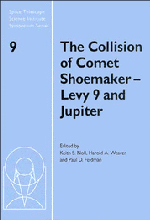Book contents
- Frontmatter
- Contents
- Participants
- Preface
- The orbital motion and impact circumstances of Comet Shoemaker-Levy 9
- Observational constraints on the composition and nature of Comet D/Shoemaker-Levy 9
- Tidal breakup of the nucleus of Comet Shoemaker–Levy 9
- Earth-based observations of impact phenomena
- HST imaging of Jupiter shortly after each impact: Plumes & fresh sites
- Galileo observations of the impacts
- Models of fragment penetration and fireball evolution
- Entry and fireball models vs. observations: What have we learned?
- Dynamics and chemistry of SL9 plumes
- Chemistry induced by the impacts: Observations
- SL9 impact chemistry: Long-term photochemical evolution
- Particulate matter in Jupiter's atmosphere from the impacts of Comet P/Shoemaker-Levy 9
- Jupiter's post-impact atmospheric thermal response
- Growth and dispersion of the Shoemaker-Levy 9 impact features from HST imaging
- Waves from the Shoemaker-Levy 9 impacts
- Jovian magnetospheric and auroral effects of the SL9 impacts
Growth and dispersion of the Shoemaker-Levy 9 impact features from HST imaging
Published online by Cambridge University Press: 12 September 2009
- Frontmatter
- Contents
- Participants
- Preface
- The orbital motion and impact circumstances of Comet Shoemaker-Levy 9
- Observational constraints on the composition and nature of Comet D/Shoemaker-Levy 9
- Tidal breakup of the nucleus of Comet Shoemaker–Levy 9
- Earth-based observations of impact phenomena
- HST imaging of Jupiter shortly after each impact: Plumes & fresh sites
- Galileo observations of the impacts
- Models of fragment penetration and fireball evolution
- Entry and fireball models vs. observations: What have we learned?
- Dynamics and chemistry of SL9 plumes
- Chemistry induced by the impacts: Observations
- SL9 impact chemistry: Long-term photochemical evolution
- Particulate matter in Jupiter's atmosphere from the impacts of Comet P/Shoemaker-Levy 9
- Jupiter's post-impact atmospheric thermal response
- Growth and dispersion of the Shoemaker-Levy 9 impact features from HST imaging
- Waves from the Shoemaker-Levy 9 impacts
- Jovian magnetospheric and auroral effects of the SL9 impacts
Summary
The Hubble Space Telescope Wide Field Planetary Camera 2 imaging data provide the highest spatial resolution of individual Shoemaker-Levy 9 impact sites. Analysis of images obtained with the F410M filter yielded horizontal translation rates of tropospheric cloud structures and the east-west components have been interpreted as zonal winds which vary with latitude. When the tropospheric zonal winds between −60° and −30°, which were derived from the SL9 images, are compared with Voyager data there are no discernible changes in the magnitude or latitudinal positions of wind minima and maxima. This result provides additional evidence of the long-term stability of the zonal winds. Changes in individual sites during a two week period in July 1994 have been mapped. Their evolution is consistent with zonal winds decreasing with height and it provides evidence that local circulation associated with isolated weather systems perturbs the lower stratosphere.
Introduction
On July 16, 1994 at 21h30–51m the first multicolor images revealed the site of the A fragment impact of Comet P/Shoemaker-Levy 9 (SL9) as it rotated into view about 1.5 hours after it formed. The lack of color dependence and the resulting orientation and morphology of the ejecta blanket had not been anticipated. The blowout region was located more to the east than expected and dark rings and crescent-shaped structures centered on the impact site were observed, but the most obvious aspect of site A was the dark core (see the chapter by Hammel).
- Type
- Chapter
- Information
- The Collision of Comet Shoemaker-Levy 9 and JupiterIAU Colloquium 156, pp. 307 - 328Publisher: Cambridge University PressPrint publication year: 1996
- 2
- Cited by

